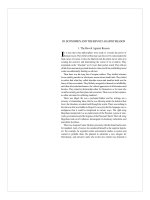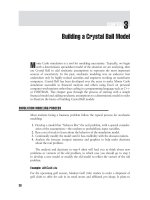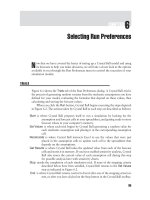Financial Modeling with Crystal Ball and Excel Chapter 3 potx
Bạn đang xem bản rút gọn của tài liệu. Xem và tải ngay bản đầy đủ của tài liệu tại đây (243.68 KB, 8 trang )
CHAPTER
3
Building a Crystal Ball Model
M
onte Carlo simulation is a tool for modeling uncertainty. Typically, we begin
with a deterministic spreadsheet model of the situation we are analyzing, then
use Crystal Ball to add stochastic assumptions to represent the most important
sources of uncertainty. In the past, stochastic modeling was an endeavor best
undertaken only by highly trained scientists and engineers working on mainframe
computers. Crystal Ball has been developed over the years to make Monte Carlo
simulation accessible to financial analysts and others using Excel on personal
computer workstations rather than coding in a programming language such as C++
or FORTRAN. This chapter goes through the process of starting with a simple
financial model and adding stochastic assumptions to a deterministic model in order
to illustrate the basics of building Crystal Ball models.
SIMULATION MODELING PROCESS
Most analysts facing a business problem follow the typical process for stochastic
modeling:
1. Develop a model that ‘‘behaves like’’ the real problem, with a special consider-
ation of the assumptions—the random or probabilistic input variables.
2. Run a set of trials to learn about the behavior of the simulation model.
3. Continually modify the model until it has credibility with the decision makers.
4. Analyze the forecast (output) statistics and graphics to help make decisions
about the real problem.
The analysis and decisions in step 4 often will lead you to think about new
problems or variants of the old problem, in which case you should go to step 1
to develop a new model or modify the old model to reflect the variant of the old
problem.
Example: AKGolf.xls
For the upcoming golf season, Alaskan Golf (AG) wishes to order a shipment of
golf clubs to offer for sale in its retail stores and affiliated pro shops. It plans to
28
Building a Crystal Ball Model
29
FIGURE 3.1 Deterministic spreadsheet model for
Alaskan Golf purchase decision.
purchase 1,000 HeMan Stick drivers—a helium-filled club that the manufacturer
promises will elevate any player’s game. AG can purchase the drivers at a cost of
$300 each, and plans to sell them during the golf season for $395 each. At the end
of the season, all remaining HeMan Sticks will be sold for $195 to clear the shelves.
AG has asked you to compute their profit if the demand for HeMan Sticks is 800
units during the season. The file AKGolf.xls shown in Figure 3.1 has a deterministic
spreadsheet model for this situation. Cell C11 shows that the profit will be $55,000
from purchasing 1,000 HeMan Sticks at the beginning of the golf season, selling 800
at $395 each during the season, and selling the remaining 200 at $195 each during
the end-of-year sale to clear the shelves.
This spreadsheet can be used to do a ‘‘what-if’’ analysis, where the demand
for drivers in C6 is changed to various values to see the effects on profit in C11.
This is informative but cumbersome, as the analyst must keep track of the input
values for C6 and the corresponding output values in C11, then somehow analyze
the results for a rudimentary form of sensitivity analysis. Monte Carlo simulation
with Crystal Ball can be regarded as a sophisticated form of ‘‘what-if’’ analysis, as
the program will keep track of all these changes during its run. Further, with Crystal
Ball it is easy to change more than one input at a time, as we will see in the next
section.
DEFINING CRYSTAL BALL ASSUMPTIONS
A stochastic input cell in Crystal Ball is called an assumption, while an output cell
is called a forecast. In this section, we will add assumptions and a forecast to the
deterministic model in AKGolf.xls to create a stochastic model.
30 FINANCIAL MODELING WITH CRYSTAL BALL AND EXCEL
TABLE 3.1 Stochastic assumptions to be added to AKGolf.xls.
Assumption Cell Distribution
Demand during Golf Season C6 Triangular(500,800,1500)
Initial Price C8 Uniform(355,395)
Sale Price C10 Uniform(175,195)
Defining Assumptions
Now let’s take into account two sources of uncertainty: (1) the demand for drivers
is stochastic, and (2) the retail clerks and golf professionals who sell the clubs at
retail are allowed to give consumers slight discounts on the listed prices.
For the demand distribution, we assume that the lowest possible demand during
the season is 500 drivers, the largest possible demand is 1,500 drivers, and the most
likely demand is 800 drivers. These three parameters are used to define a triangular
probability distribution in the manner shown below. To keep things simple, we will
assume that all drivers left unsold at the end of the season will be sold during the
end-of-year sale at the sale price in Cell C10.
The golf professionals are allowed to give their customers discounts of up to 10
percent on both the initial prices and the sales prices, which reduce their commissions
proportionately. To model this discounting, we assume that the average initial price
of drivers sold during the season isuniform with a minimum of $355, and a maximum
of $395. The average end-of-season sales price is uniform with a minimum of $175,
and a maximum of $195. Table 3.1 summarizes the Crystal Ball assumptions to be
added to the model in file AKGolf.xls.
Follow the steps below to define the assumptions in Cell C6:
1. Select cell C6, then click on Cell→Define Assumption.
2. Choose the triangular distribution from the distribution gallery (Figure 3.2).
3. Entertheparametervaluesandanamefortheassumption.Bydefault,CB will look
first for an Excel-defined named, then in the cells at immediate left and just above
for an assumption name. Figure 3.3 shows where to enter the parameter values.
4. Click Enter to see a depiction of the defined distribution. Your distribution
should look like that shown in Figure 3.3. Press OK to return to the spreadsheet.
It is OK to press OK without seeing the depiction, but pressing Enter first is
good practice to check that the entered distribution is what you intend to use.
Cell C6 will turn green to indicate that an assumption cell is defined there. By
following the steps above for cell C6, it should be straightforward for you to define
the stochastic assumptions listed for cells C8 and C10 in Table 3.1.
If an error occurs in step 1, try entering an arbitrary numerical value in the cell
first—Crystal Ball needs to recognize the location as a number cell. In Crystal Ball 7.2
and higher, when you attempt to define an assumption in an empty cell, a value of 0
Building a Crystal Ball Model
31
FIGURE 3.2 Distribution gallery showing the triangular and
normal distributions. To see all of Crystal Ball’s distributions, click
on All at upper left and use the upper set of scroll bars to move
through the distributions.
FIGURE 3.3 Defining the demand assumption for the Alaskan Golf
purchase decision. Note that both the Name: and the Units: can be specified
with a cell reference.
32 FINANCIAL MODELING WITH CRYSTAL BALL AND EXCEL
FIGURE 3.4 Defining the demand assumption for the Alaskan Golf purchase decision.
will be entered for you automatically. You cannot define an assumption in a cell
that holds an Excel formula. If you try to do so, Crystal Ball will give you an error
message.
Defining Profit as a Forecast Cell
A stochastic output cell in a Crystal Ball model is called a forecast cell. To define
cell C11 as a forecast cell, follow the steps below:
1. Select cell C11, then click on Cell→Define Forecast.
2. Enter the name and units (optional) in the text boxes (Figure 3.4).
3. Click OK.
Cell C11 will turn blue to indicate that a forecast cell is defined there. When
you run the simulation, the forecast values will be calculated and collected for each
run, then displayed graphically in a forecast window.
RUNNING CRYSTAL BALL
It is usually a good idea at this point to run just one iteration of the simulation
to make sure that the calculations appear to be correct. To run one iteration, click
Run→Single Step, then make sure that the model correctly reflects the new values
showing in the assumption cells. This is good practice to help debug the logic of the
model.
When you are ready to run the model, click Run→Run, or just click the
Run icon on the Crystal Ball toolbar. The forecast window should appear auto-
matically. When the simulation stops you can use it to analyze the output
as shown in Chapter 2. Your forecast chart should resemble that shown in
Figure 3.5.
Building a Crystal Ball Model
33
FIGURE 3.5 Profit forecast for the Alaskan Golf purchase decision. Note that the probability of
negative profit is less than 5 percent.
SOURCES OF ERROR
Monte Carlo simulation modeling is similar to statistical sampling in many respects,
but differs in the type of up-front creativity required by the analyst. To compare and
contrast statistical sampling and simulation modeling, Figure 3.6 shows a stylized
view of steps taken in conducting a statistical study and a simulation study.
In a statistical study, the analyst defines a population to study, specifies numerical
measures to be obtained, and develops a sampling frame—a list of all potential
population elements that could potentially be included in a sample. The statistical
analyst then randomly selects a sample of elements from the sampling frame and
calculates sample statistics such as the mean and standard deviation. These sample
statistics are then used to make inferences about the population using procedures
such as hypothesis tests or confidence intervals. Virtually every introductory statistics
textbook covers these inferential statistical procedures. Note that no matter what
the stated population of interest, it is the sampling frame that actually defines the
population about which inferences can be made in a statistical study.
In a simulation study, the analyst builds a model to represent the business
problem of interest, runs the simulation, analyzes the output, then makes a
decision—which can sometimes be simply to improve the model and rerunning
several times before making a decision about the business problem. Crystal Ball is
designed to run the simulations and provide graphical and numerical summaries
34 FINANCIAL MODELING WITH CRYSTAL BALL AND EXCEL
Statistical Study
Simulation Study
Define
Population
Build
Model
Run
Simulation
Analyze
Output
Make
Decisions
Select
Sample
Calculate
Statistics
Make
Inference
FIGURE 3.6 Stylized depictions of a statistical study and a
simulation study.
of the output (forecasts) automatically and flawlessly. However, no matter what
the stated business problem, it is the model that defines the problem about which
decisions can be made in a statistical study.
Statistical analysts are concerned with both sampling and nonsampling error.
Sampling error stems from the fact that sample statistics will differ from population
parameters simply by chance. Well-established theory tells us all we need to know
to control sampling error in a well-executed statistical study. Nonsampling error
is more insidious, coming about from faulty methods of data collection, incorrect
sampling methods, errors in recording data, or erroneous entry of the data into the
computer. It is difficult or perhaps even impossible to find and eliminate all sources
of nonsampling error, although many professional statistical consulting firms have
devised methods to eliminate most sources of nonsampling error based on long
experience.
Crystal Ball is well debugged and tested, so there is no worry about the accuracy
of its algorithms. By far, the biggest concern in a simulation study is model error.
Model error is present because any model is an abstraction that cannot take into
account every detail and nuance of the real problem. By definition, a model contains
only the stochastic relationships that are most germane to the problem. All models
are wrong to the extent that they omit minor details. Good models are useful if
they include enough of the major details to help a decision maker reach a properly
informed decision.
It is easy to create a bad model. Model risk is the risk of using the wrong model,
implementing the correct model incorrectly, failing to assess the stochastic inputs
adequately, or omitting important stochastic inputs that should be included. Good
model building is a craft that requires some experience to develop. Fortunately, this
craft can be learned by studying the models in this book and those available from
other sources, such as the Web site www.crystalball.com.
Simulation error is caused by the fact that simulation is a sampling experiment.
This is the same as sampling error in a statistical study. Simulation error should not
be ignored, but is usually a lesser problem than model error because it is relatively
inexpensive to reduce simulation error by simply increasing the number of trials.
Building a Crystal Ball Model
35
It can also be measured and controlled through the variance reduction techniques
described in Appendix C.
CONTROLLING MODEL ERROR
Good models have three basic requirements:
1. Verification. Ensuring that the values and formulas are entered correctly in
Excel.
2. Validation. Assuring that your model faithfully mimics the actual situation or
system.
3. Credibility. Acceptance of your verified and validated model for use by deci-
sion makers.
Verification should be done at every step along the way. The Excel auditing tools
can be very useful for this purpose, and you should strive to make your models as
readable as possible so that you and others can understand the logic of the model
when you come back to it after setting it aside for some time.
Validation is done using a verified model. A validated model will give outputs
that seem to be reasonable to a subject matter expert. Proper validation of a model
is part of the craft of modeling that takes some experience to learn.
A credible model is obtained when a verified and validated model is accepted
for use by the decision makers. Credibility is earned over time, and it is usually best
to keep decision makers informed about your progress in building the model, and
to solicit their input at several points during the model building process. This will
help get ‘‘buy-in’’ from them when it comes to put the model to work.
This chapter describes the basic steps involved in building models. As you go
through the models in the rest of the book, you will begin to get a feel for how best
to go about creating models for your own purposes. The next chapter takes a more
in-depth view of selecting and specifying Crystal Ball assumptions.









